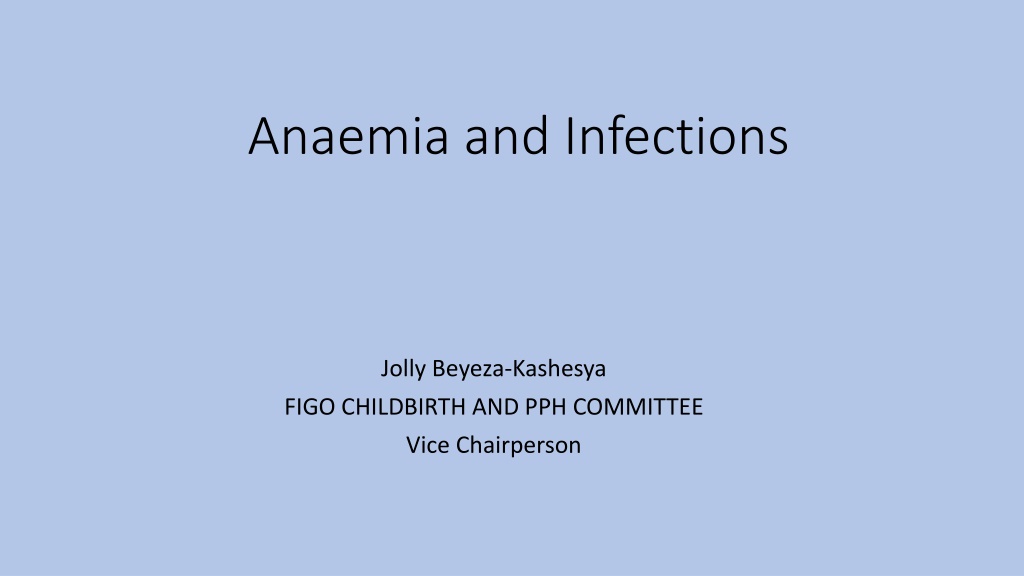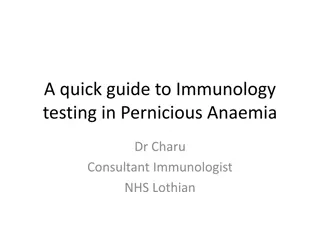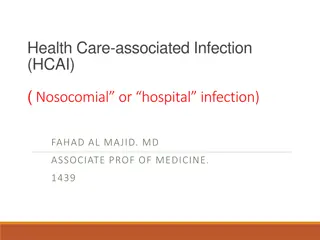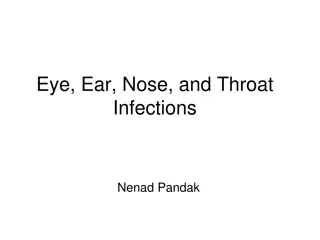Understanding Anaemia and Infections in Relation to Health
Anaemia can result from various causes such as blood loss, increased destruction of red blood cells, and impaired production, often linked to infections and chronic diseases. Parasites, bacteria, and viruses play a role in the progression of anaemia, affecting the body's ability to produce and utilize iron effectively. Infections can lead to inflammation and changes in the immune system, further complicating the condition. Both acute and chronic infections, including tuberculosis and HIV, can contribute to anaemia, highlighting the intricate relationship between health and disease.
Download Presentation

Please find below an Image/Link to download the presentation.
The content on the website is provided AS IS for your information and personal use only. It may not be sold, licensed, or shared on other websites without obtaining consent from the author. Download presentation by click this link. If you encounter any issues during the download, it is possible that the publisher has removed the file from their server.
E N D
Presentation Transcript
Anaemia and Infections Jolly Beyeza-Kashesya FIGO CHILDBIRTH AND PPH COMMITTEE Vice Chairperson
Causes of Anaemia Blood loss Increased destruction Impaired Production Acute Chronic Infections Autoimmune Enzyme deficiencies Haemoglobinopathies Chronic Diseases Iron deficiency Megaloblastic Anaplastic INFECTIONS INFECTIONS INFECTIONS
Blood Loss_Parasites Hookworm Ancylostoma duodenale Nector americanus Trichuris Trichura Schistosoma Haematobium Bladder
Increased Destruction of Red Blood Cells Parasites Plasmodium species Bacteria E. Coli Clostridium perfringens Mycobacteria pneumonia Viruses Infectious Mononucleosis (EBV) Hepatitis A Virus
Impaired Production Parasites Leishmania Diphyllobothrium Latum Impaired absorption of Vit. B12 Megaloblastic anaemia Viruses HIV Human Parvovirus Cytomegalovirus Epstein-Barr-virus Human Herpes virus Varicella Zoster Virus Bacteria TB Helicobacter Pylori Vit B12 absorption
Infection and Anaemia Infection or disease causes inflammation Changes in the Immune system Anaemia of inflammation. Low serum iron and normal/high ferritin levels Your body may not store and use iron normally. Decreases bioavailability of iron to host tissues Parasitic diseases Both extracorporeal iron loss and anemia of inflammation
Anaemia in Acute Infections Destruction of red blood cells by the parasite. E.g. in Malaria Inhibition of medullary erythropoiesis Parvovirosis (Parvoviruses)
Anaemia in chronic Infections Chronic infections (e.g., tuberculosis, lung abscess, and endocarditis) HIV infection Hook worm infestation Autoimmune diseases or diseases with inflammation Rheumatoid arthritis, lupus, ulcerative colitis, Crohn's disease
Anaemia in TB Nutritional deficiency, malabsorption Low dietary intake is one of the causes resulting in IDA. Loss of appetite, a classic symptom of TB, may be the reason for reduced dietary intake. Anti-tuberculosis therapy vitamin D deficiency was associated with an increased risk of developing active TB Isonicotinic acid hydrazide (isoniazid, INH), an antituberculosis agent, can cause sideroblastic anaemia as a side-effect Development of immune haemolytic anaemia (IHA) during intermittent rifampicin administration
Anaemia in HIV infection Insufficient erythropoietin levels serum immunoreactive erythropoietin in HIV infected patients across the spectrum of disease stages revealed that levels of the hormone failed to rise commensurately with increasing anaemia. Nutritional deficiency, malabsorption ART: Nucleoside Reverse Transcriptase Inhibitors (NRTIs) such as zidovudine (AZT) and lamivudine (3TC) cause hematologic toxicity, including anemia Tenofovir (TDF)










![Enhancing Patient Blood Management in Pregnancy at [INSERT LOCAL HOSPITAL NAME]](/thumb/143207/enhancing-patient-blood-management-in-pregnancy-at-insert-local-hospital-name.jpg)












